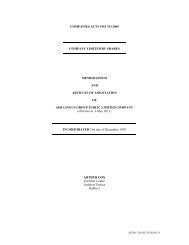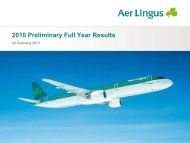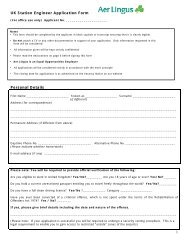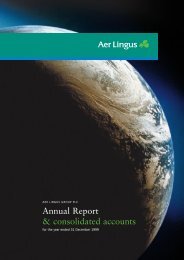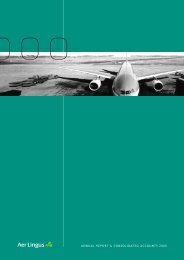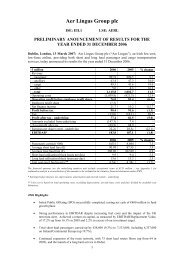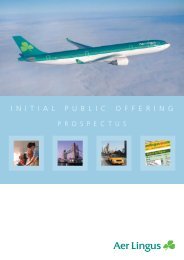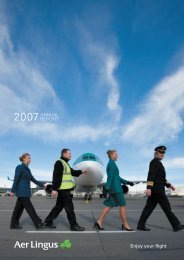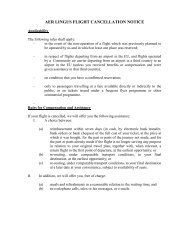annual report 2009 - Aer Lingus
annual report 2009 - Aer Lingus
annual report 2009 - Aer Lingus
You also want an ePaper? Increase the reach of your titles
YUMPU automatically turns print PDFs into web optimized ePapers that Google loves.
Financial Statements <strong>Aer</strong> <strong>Lingus</strong> Group Plc – Annual Report <strong>2009</strong>552 Summary of significant accounting policies [continued]• Improvements to IFRSs (April <strong>2009</strong>)– IFRS 2 Share-based Payments (effective 1 July <strong>2009</strong>)– IFRS 5 Non-current Assets Held for Sale and Discontinued Operations (effective 1 January 2010)– IFRS 8 Operating Segments (effective 1 January 2010)– IAS 1 Presentation of Financial Statements (effective 1 January 2010)– IAS 7 Statement of Cash Flows (effective 1 January 2010)– IAS 17 Leases (effective 1 January 2010)– IAS 18 Revenue (effective 1 April <strong>2009</strong>)– IAS 36 Impairment of Assets (effective 1 January 2010)– IAS 38 Intangible Assets (effective 1 July <strong>2009</strong>)– IAS 39 Financial Instruments: Recognition and Measurement (effective 1 January 2010)– IFRIC 9 Reassessment of Embedded Derivatives (effective 1 July <strong>2009</strong>)– IFRIC 16 Hedge of a Net Investment in a Foreign Operation (effective 1 July <strong>2009</strong>)Other than IAS 24 (Revised) and IFRS 9, for which the Directors have not yet had an opportunity to consider the potential impactof adoption, the above standards and amendments are not expected to have a significant impact on the Group’s financial statements.2.2 Consolidation(a) SubsidiariesSubsidiaries are all entities (including special purpose entities) over which the Group has the power to govern the financial andoperating policies, generally accompanying a shareholding of more than one half of the voting rights. The existence and effect ofpotential voting rights that are currently exercisable or convertible are considered when assessing whether the Group controls anotherentity. Subsidiaries are fully consolidated from the date on which control is transferred to the Group. They are de-consolidated fromthe date that control ceases.The purchase method of accounting is used to account for the acquisitions of subsidiaries by the Group. The cost of an acquisitionis measured as the fair value of the assets given as consideration plus equity instruments issued and liabilities incurred or assumed at thedate of exchange, plus costs directly attributable to the acquisition. Identifiable assets acquired and liabilities and contingent liabilitiesassumed in a business combination are measured initially at their fair values at the acquisition date, irrespective of the extent of anyminority interest. The excess of the cost of acquisition over the fair value of the Group’s share of the identifiable net assets acquired isrecorded as goodwill. If the cost of acquisition is less than the fair value of the net assets of the subsidiary acquired, the difference isrecognised directly in the income statement.Inter-company transactions, balances and unrealised gains on transactions between group companies are eliminated. Unrealisedlosses are also eliminated unless the transaction provides evidence of an impairment of the asset transferred.The financial statements of all subsidiaries are drawn up to the year ended 31 December. Accounting policies of subsidiaries havebeen changed where necessary to ensure consistency with the policies adopted by the Group.2.3 Segment <strong>report</strong>ingOperating segments are <strong>report</strong>ed in a manner consistent with the internal <strong>report</strong>ing provided to the chief operating decision-maker.The chief operating decision-maker, who is responsible for allocating resources and assessing performance of the operating segments,has been identified as the Chief Executive Officer.2.4 Foreign currency translation(a) Functional and presentation currencyThe consolidated financial statements are presented in euro, which is the functional and presentation currency of the Companyand all of its trading subsidiaries.(b) Transactions and balancesForeign currency transactions are translated into the functional currency using the exchange rates prevailing at the dates of thetransactions or valuation where items are remeasured. Foreign exchange gains and losses resulting from the settlement of suchtransactions and from the translation at year-end exchange rates or monetary assets and liabilities denominated in foreign currenciesare recognised in the income statement, except when deferred in equity as qualifying cash flow hedges.



